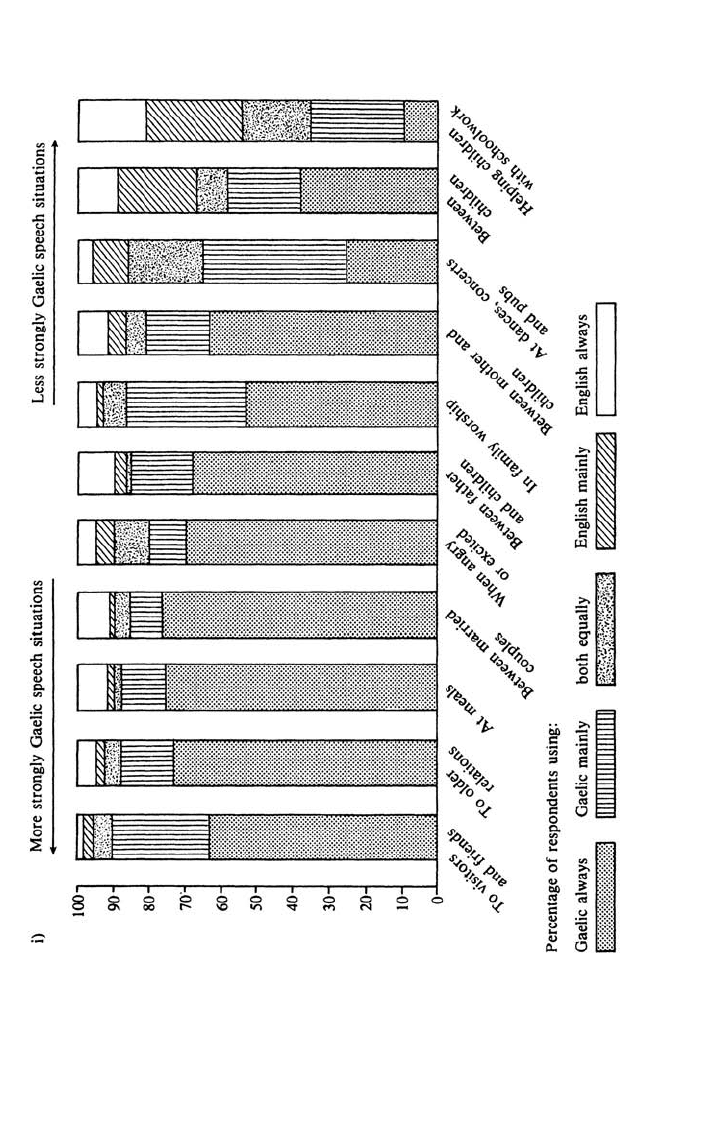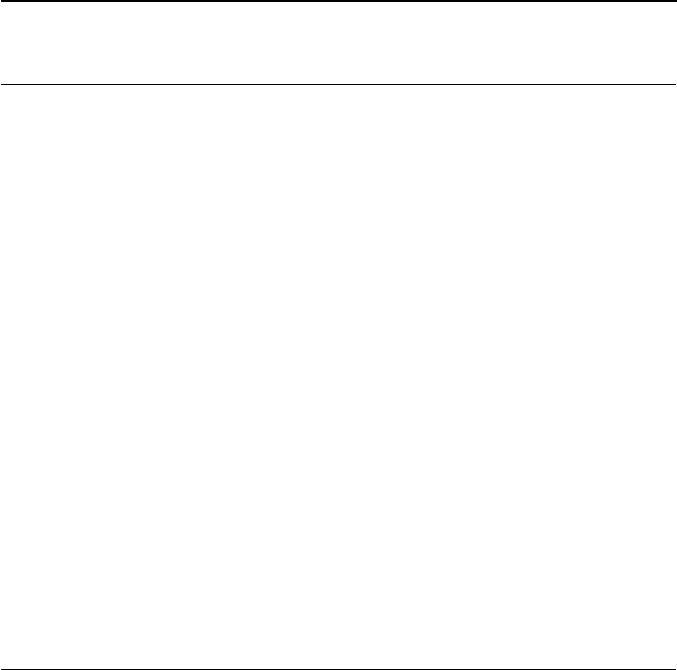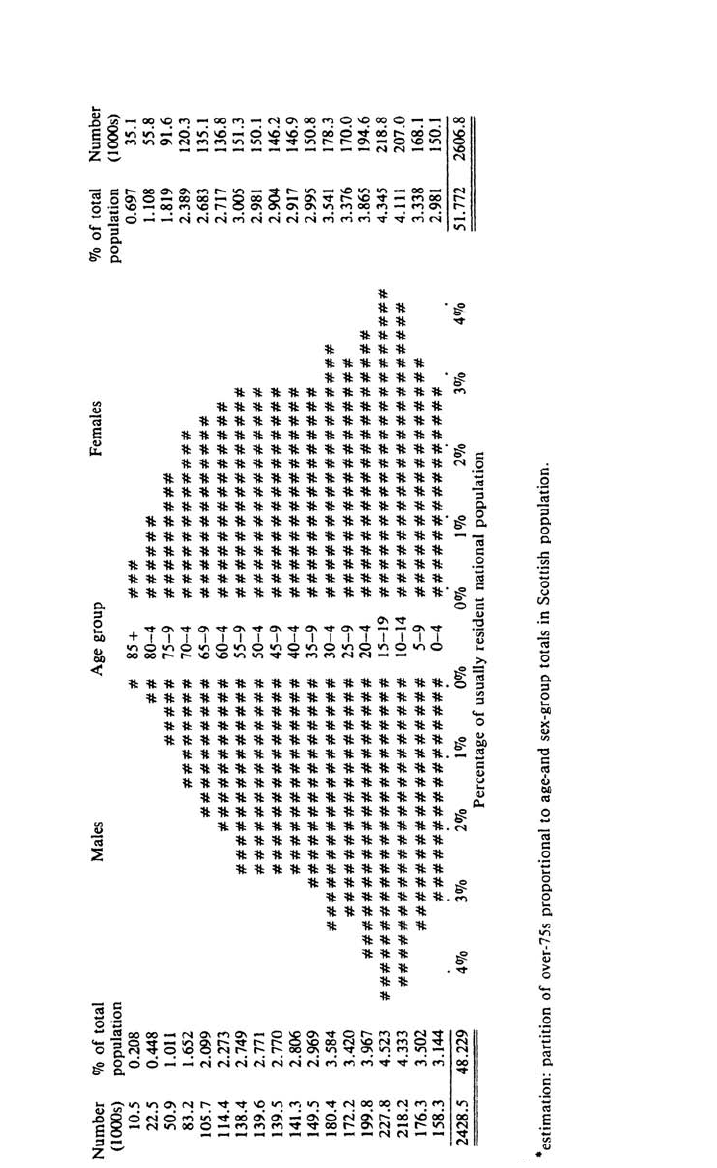Ball Martin, M?ller Nicole. The Celtic Languages
Подождите немного. Документ загружается.


Figure 13.9b Western Isles (Harris), 1978 survey – Gaelic usage in present- day family. Source: MacKinnon and
MacDonald, Appendix: 2–4

SCOTTISH GAELIC TODAY 607
These details are subsumed into a ‘Gaelic usage score’ in Tables 13.2 and 13.3, where
a response of ‘Gaelic always’ is weighted as one, and ‘Gaelic often’ as a half. The scores
are expressed as percentages of totals of responding Gaelic speakers in the samples. There
were 106 fully fl uent native Gaelic speakers in the Barra sample, and 96 in South Harris.
The speech situations are presented in the order of greatest- to- least intergenerational lan-
guage shift from Gaelic to English. In both island samples the usage of Gaelic was well
nigh universal in almost every speech situation in respondents’ original families, except-
ing helping children with schoolwork, and at public entertainments. Intergenerational
language shift from Gaelic to English was strongest in both samples among children, and
quite strong also in the domains of worship and public entertainment. In this process the
family can be clearly seen as a conserving institution – but if community usage slackens it
will clearly be by itself an insuffi cient institution for language maintenance.
Table 13.2 Gaelic usage and intergenerational language shift, Isle of Barra, 1978
(N = 106). Source: MacKinnon and MacDonald 1980, Appendix: 2–4
Speech situation Mean Gaelic usage scores in: Intergenerational
usage change
(language shift)
original family present family
Helping child with
schoolwork
58.3 32.9 –25.4
Between children 90.0 65.5 –24.5
To grandparents/older
family members
100.0 84.4 –15.6
At dances, concerts and
pubs
87.3 71.7 –15.6
In family worship 87.1 71.6 –15.5
With visitors and friends 95.3 81.0 –14.3
When angry or excited 92.0 77.9 –14.1
Between father and
children
93.3 82.2 –11.1
Between mother and
children
92.5 82.3 –10.2
Between parents/married
couple
92.5 86.6 –6.8
At mealtimes 92.9 88.7 –4.2

608 THE SOCIOLINGUISTICS OF THE CELTIC LANGUAGES
Table 13.3 Gaelic usage and intergenerational language shift, South Harris, 1978
(N = 96). Source: MacKinnon and MacDonald 1980, Appendix: 2–4
Speech situation Mean Gaelic usage scores in: Intergenerational
usage change
(language shift)
original family present family
Between children 91.6 55.2 –36.4
At dances, concerts and
pubs
75.6 49.3 –26.3
In family worship 94.3 71.9 –22.4
When angry or excited 94.8 77.1 –17.7
With visitors and friends 95.8 79.2 –16.6
Between mother and
children
93.8 78.1 –15.7
Between father and
children
94.3 83.3
–11.0
At mealtimes 95.8 84.9 –10.9
Between parents/married
couple
96.4 86.4 –10.0
Helping child with
schoolwork
27.2 22.7 –4.5
To grandparents/older
family members
100.0 98.6 –1.4
The third survey, undertaken in 1986–8 in the Isle of Skye, shows this with particular clar-
ity. Gaelic to English- language shift was acute in the south and east of the island, and
Gaelic language maintenance was stronger in the north and west. Table 13.4 (opposite)
presents data on a basis similar to Tables 13.2 and 13.3 for 16 similar speech situations
among the 81 Gaelic speakers in the whole Isle of Skye sample (MacKinnon 1988a: 12).

SCOTTISH GAELIC TODAY 609
Table 13.4 Gaelic usage and intergenerational language shift – Isle of Skye, 1986–8
(N = 81). Source: MacKinnon 1988a: 12, Table 3.1
Speech situation Mean Gaelic usage scores in: Intergenerational
usage change
(language shift)
original family present family
Between child and
grandparents
98.5 35.0
–63.5
Adult explaining to child
85.5 22.5 –63.0
Between brothers and
sisters
88.0 25.5 –62.5
Between father and child
93.5 39.0
–54.5
Between parents and child
93.5 40.0 –53.5
Between children and
friends
81.5 30.0 –51.5
Between mother and child
92.0 41.5 –50.5
Helping child with
schoolwork
53.0 16.0
–37.0
Between married couple
96.0 62.5 –33.5
At mealtimes
92.5 62.0 –30.5
When counting
64.0 34.0 –30.0
When angry or excited
87.0 67.0
–20.0
To animals or pets
95.5 76.5
–19.0
Between parents and older
generation
99.5
83.0
–16.5
When thinking
83.5
67.0
–16.5
With neighbours and
friends
–92.5 76.5 –16.0
Comparative data for the Western Isles in the 1986–8 survey are presented in Figure
13.10.
The strong impression in comparing the situation in Skye and the Western Isles in
1986–8 with Barra and South Harris ten years earlier, and the Isle of Harris fi ve years
earlier still, is of much stronger intergenerational language shift. The 1986–8 survey,
however, looked at more inner- speech situations and in these Gaelic was being better
maintained, as it was with friends, neighbours and the older generation.
If these surveys are indeed typical of their then Gaelic- speaking communities, the
intergenerational changes in diglossic usage patterns indicated something of the process
and dynamics of language shift. Speech exchanges with and between children represented

610 THE SOCIOLINGUISTICS OF THE CELTIC LANGUAGES
the situations of greatest shift to English, schoolwork always having represented a domain
within which English predominated. However, it is not only the school which has thrust
English as an intrusion into the social life of the Gaelic community. Worship seems to
have started to do the same. The use of English in both family worship and Sunday school
shows two potential areas of internal weakening of the Gaelic ‘demesne’, or social area
within which the language predominates (MacKinnon 1977: 148f.).
Public events are similar situations within which Gaelic speakers increasingly see
themselves constrained to use English. This is illustrated in the comparison with Gaelic
usage scores among Gaelic speakers in the more Gaelic north and west, and the more
anglicized south and east divisions of Skye in Table 13.5.
0% 20% 40% 60% 80% 100%
Always/mainly
Gaelic
Both languages
equally
Always/mainly
English
To grandparents 86/7
To grandparents 94/5
To grandparents 04/5
To own parents 86/7
To own parents 94/5
To own parents 04/5
To spouse/partner 86/7
To spouse/partner 94/5
To spouse/partner 04/5
Parents to children 86/7
Parents to children 94/5
Parents to children 04/5
Between children 86/7
Between children 94/5
Between children 04/5
Figure 13.10 Intergenerational language shift: Western Isles’ Gaelic speakers at
successive surveys, 1986–8 (N = 224), 1994–5 (N = 130) and 2004–5 (N = 254)

SCOTTISH GAELIC TODAY 611
Table 13.5 Gaelic usage in media and community, Skye Gaelic speakers, 1986–8
(N = 81). Source: MacKinnon 1988a: 19–25
Mean Gaelic usage scores among Gaelic speakers
Speech situation Skye N & W
(N = 52)
Skye S & E
(N = 29)
Skye total
(N = 81)
Gaelic radio programmes
88.0 94.6 90.5
Gaelic TV programmes
84.8 89.3 86.5
With church elder
89.3 84.2 82.8
In crofting activities
84.2 75.0 82.0
At prayer meetings
72.2 37.5 64.3
Gaelic press articles
60.3 71.2 63.5
With minister
80.9 26.9 61.6
At work
56.5 64.7 60.0
With local nurse
70.7 31.1 57.1
At social events
61.3 46.0 55.4
With crofting assessor
57.9 33.3 52.0
At township meetings
61.1 31.3 51.9
At church services
58.5 39.6 51.5
With local councillor
42.5 60.0 48.3
Reading Gaelic Bible
56.4 35.2 47.7
With child’s teacher
53.6 39.3 46.4
Gaelic concerts, plays
35.0 58.9 43.6
At post offi ce
57.6 15.5 41.3
Reading Gaelic books
26.9 24.1 25.8
When shopping locally
23.8 20.8 23.1
To doctor
27.7 1.7 17.8
With bank teller
12.5 4.0 9.3
Writing letter in Gaelic
9.1 7.4 8.3
With local offi cials
1.5 2.9 2.0
With DHSS/tax offi cals
1.3 2.4 1.7
With local policeman 0.0 1.8 0.7

612 THE SOCIOLINGUISTICS OF THE CELTIC LANGUAGES
The decay of Gaelic usage in the religious domain in the more anglicized south and
east division of Skye was apparent in the responses to reading the Gaelic Bible, language
used at church services and prayer meetings, and in exchanges with ministers. Use of
Gaelic within the media stood up well, although there was some slippage in the crofting
domain (croft work, township meetings and crofting assessors).
The items in Table 13.5 are rank ordered from those in which Gaelic most strongly pre-
dominates to those in which English is almost universally used among the Gaelic speakers
in the 1986–8 Skye adult- population sample of 145 locally registered electors.
The low usage scores for reading Gaelic books and writing Gaelic letters undoubt-
edly refl ect the low priority given to Gaelic literacy in schooling until very recently.
The low Gaelic usage scores associated with the post offi ce in Skye south and east, and
for shopping locally in both divisions refl ect the takeover of these small businesses by
non- Gaelic- speaking outsiders. The low scores associated with local professionals and
offi cials refl ect the fact that very few of them are Gaelic- speaking – and even with those
few who are, the predominating use of English is very strongly associated with their
offi ce. The local education system has become much more supportive of Gaelic since the
mid- 1970s, especially at the primary stage, and Gaelic literacy is taken seriously as an
aspect of language maintenance. Although there have been some supportive public utter-
ances from time to time in connection with other public services (e.g., the police), until
there is some concerted policy of recruitment and placement of Gaelic speakers in Gaelic-
speaking areas, these services will continue as strongly anglicizing factors in local life.
The exception here is in local nursing, where district nurses and midwives have typically
been local or Gaelic- speaking.
Support for Gaelic policies was also examined in this survey, and the results for West-
ern Isles respondents are presented in Table 13.6.
Table 13.6 Attributes associated with Gaelic policies support scores (Western Isles
Survey 1986–88)
(a) from Language- Maintenance and Viability Project 1986–8. Western Isles Gaelic
Speakers (N = 224). Source: MacKinnon 1994a; Support: ESRC G00232328
Language
usage
Grand-
parents
(no.) (%)
Own
parents
(no.) (%)
Spouse/
partner
(no.) (%)
To
children
(no.) (%)
Between
children
(no. (%)
Gaelic always/
mainly
212 95.9 212 96.4 117 72.7 80 55.2 45 35.5
Both langs
equally
3 1.4 1 0.4 18 11.2 37 25.5 29 22.8
English
always/mainly
6 2.7 7 3.2 26 16.1 28 19.3 53 41.7
Total
responding
221 100.0 220 100.0 161 100.0 148 100.0 127 100.0
Non-
responding
3 4 63 76 97

SCOTTISH GAELIC TODAY 613
(b) From Euromosaic Project National Gaelic Speaker Survey 1994–5). Western
Isles Gaelic Speakers (N = 130). Source: Euromosaic 1995. Support: EU Task Force
Resources Humaines/Euromosaic project
Language
usage
Grand-
parents
(no.)
(mean
of 2)
(%)
Own
parents
(no.) (%)
Spouse/
partner
(no.) (%)
To
children
(no.) (%)
Between
children
(no.) (%)
Gaelic
always/
mainly
195 88.2 107 83.6 45 69.2 38 49.4 18 28.6
Both langs
equally
12 5.5 7 5.5 12 15.8 15 19.4 13 20.6
English
always/
mainly
14 6.3 14 10.9 19 25.0 24 31.2 32 50.7
Total
responding
221 100.0 128 100.0 76 100.0 77 100.0 63 100.0
Non-
responding
39 2546367
(c) From Western Isles Language Plan Project 2004–5. Western Isles Gaelic Speakers
(N = 254). Source: WILPP 2005; Support: W. I. Gaelic Language and Culture Forum.
Analysis and Presentation Copyright © 2008 K. MacKinnon, SGRÙD Research.
Language
usage
Grand-
parents
(no.) (%)
Own
parents
(no.)
(mean
of both
parents)
(%)
Spouse/
partner
(no.) (%)
To
children
(no.) (%)
Between
children
(no.) (%)
Gaelic always/
mainly
639 8.66 136 64.76 71 40.80 67 33.84 27 17.42
Both langs
equally
32 4.70 20 9.52 28 16.09 42 21.21 26 16.77
English
always/mainly
10 1.47 54 25.72 75 43.11 89 44.95 102 65.81
Total
responding
1,016 100.00 210 100.00 174 100.00 198 100.0 155 100.00
Non-
responding
335 298 80 56 99

614 THE SOCIOLINGUISTICS OF THE CELTIC LANGUAGES
GAELIC IN SCHOOLING AND THE FAMILY
The trends that continued and accelerated rapidly through the later twentieth century
clearly imply that the concept of providing educational and cultural support for Gaelic
only in the traditional ‘Gaelic- speaking areas’ has been substantially overtaken by events.
This was realized by young Gaelic- speaking parents across Scotland in the early 1980s.
Provision of primary bilingual education and of Gaelic as a ‘second language’ was fail-
ing to reach the majority of its potential Gaelic public. Although it produced census effects
of growth of Gaelic among children of school age (as shown in Figures 13.11–13.16,
pp. 615–20), these effects were limited to the areas where these facilities existed (see
Figure 13.17, p. 621), and did not produce an overall growth of Gaelic speakers among
young people nationally which came anywhere near the levels necessary for maintenance
of the language group.
A pre- school Gaelic organization, Comhairle nan Sgoiltean Àraich (CNSA), was estab-
lished in 1982 and had considerable success in establishing Gaelic pre- school units, or
croileagain. By 1990–1 there were 1,420 children enrolled in Gaelic- medium pre- school
groups, and by 1994–5 the number had increased to 2,600. In 1990–1 education authority
Gaelic nurseries commenced, and further fi gures for CNSA pre- school groups have not
been published. However, these developments at preschool level were potentially produc-
ing Gaelic- speaking children in suffi cient numbers to regenerate the language group.
On the other hand, there was a substantial shortfall in transfer to Gaelic- medium primary
units, which were not provided in suffi cient numbers to cope with such levels of demand,
and in fact growth in this sector stalled in the later 1990s/early 2000s. Despite some growth
of provison of Gaelic- medium secondary provision in this period, the substantial shortfall
of Gaelic- medium primary children transferring to Gaelic- medium secondary education
continued. As constituted at present, Gaelic education is able to do little more than slow
down the rate of attrition of the Gaelic community. Although some small census growth
among young people can be demonstrated, it is of the order of a ‘blip on the chart’ and not
yet be at a level which would overcome the decline of Gaelic transmission in the family.
To overcome the losses of Gaelic speakers from all causes in 1991–2001 there would
have needed to have been at least a cohort of 733 Gaelic- medium children per school
year proceeding through all educational sectors from pre- school to secondary. In 2007–8)
Gaelic nurseries were catering for 718 pre- school children, with an unknown number in
CNSA pre- school groups. Together these may well have been producing the necessary
numbers for language- group maintenance and transfer to the primary sector. However, in
2007–8) the average year cohort in Gaelic- medium primary schooling was 309, and the
numbers in the fi rst two years of secondary schooling were 143 and 108 respectively. Even
if these fi gures are augmented with the 248 and 208 ‘Gaelic- fl uent’ children, the system is
producing less than half the numbers necessary for language- group maintenance.
The situation in the family is crucial for the maintenance of Gaelic, and currently
family structures cause considerable diffi culties for the intergenerational transmission of
the language. In 2001 there were 13,906 households with Gaelic- speaking adults through-
out Scotland. Of these, only 2,855 had two Gaelic- speaking adults (i.e. in most cases,
of two Gaelic- speaking parents.) These comprised only 20.5 per cent of all households
with Gaelic speakers, and only 68.4 per cent of their children aged 3–15 years were being
brought up to speak Gaelic. In addition there were 257 other ‘couple families’ and 257
‘multiple households’ together comprising 3.70 per cent of all households with Gaelic-
speaking adults. These were probably multiple generational or extended families of
various types. The other ‘couple families’ were transmitting Gaelic to 82.0 per cent of

Figure 13.11 Scotland 1981: age and sex structure of national population. Sources: Registrar General (Scotland), 1983: p. 4, Table 2; Offi ce
of Population Censuses and Surveys, 1983
